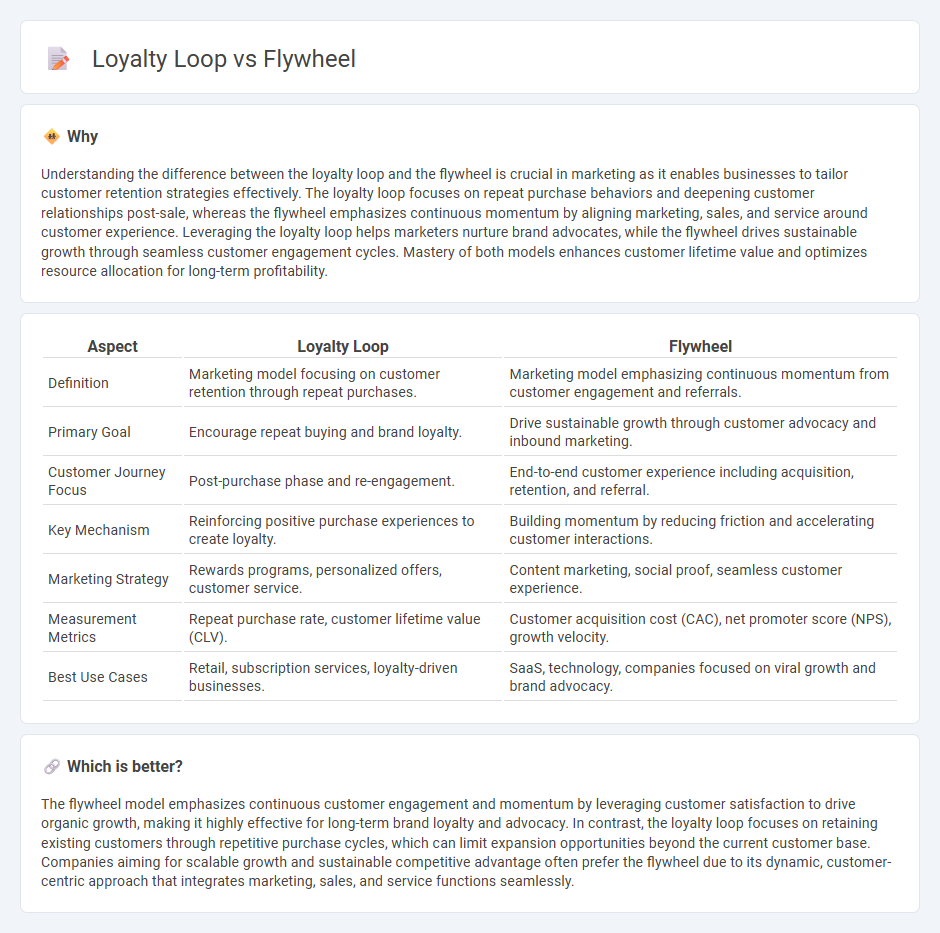
The loyalty loop focuses on retaining customers by encouraging repeat purchases through satisfaction and personalized engagement, whereas the flywheel model emphasizes continuous momentum by integrating marketing, sales, and customer service to create a self-sustaining growth system. Both strategies aim to maximize customer lifetime value but differ in approach and execution. Discover how these models can transform your marketing strategy and drive sustainable business growth.
Why it is important
Understanding the difference between the loyalty loop and the flywheel is crucial in marketing as it enables businesses to tailor customer retention strategies effectively. The loyalty loop focuses on repeat purchase behaviors and deepening customer relationships post-sale, whereas the flywheel emphasizes continuous momentum by aligning marketing, sales, and service around customer experience. Leveraging the loyalty loop helps marketers nurture brand advocates, while the flywheel drives sustainable growth through seamless customer engagement cycles. Mastery of both models enhances customer lifetime value and optimizes resource allocation for long-term profitability.
Comparison Table
| Aspect | Loyalty Loop | Flywheel |
|---|---|---|
| Definition | Marketing model focusing on customer retention through repeat purchases. | Marketing model emphasizing continuous momentum from customer engagement and referrals. |
| Primary Goal | Encourage repeat buying and brand loyalty. | Drive sustainable growth through customer advocacy and inbound marketing. |
| Customer Journey Focus | Post-purchase phase and re-engagement. | End-to-end customer experience including acquisition, retention, and referral. |
| Key Mechanism | Reinforcing positive purchase experiences to create loyalty. | Building momentum by reducing friction and accelerating customer interactions. |
| Marketing Strategy | Rewards programs, personalized offers, customer service. | Content marketing, social proof, seamless customer experience. |
| Measurement Metrics | Repeat purchase rate, customer lifetime value (CLV). | Customer acquisition cost (CAC), net promoter score (NPS), growth velocity. |
| Best Use Cases | Retail, subscription services, loyalty-driven businesses. | SaaS, technology, companies focused on viral growth and brand advocacy. |
Which is better?
The flywheel model emphasizes continuous customer engagement and momentum by leveraging customer satisfaction to drive organic growth, making it highly effective for long-term brand loyalty and advocacy. In contrast, the loyalty loop focuses on retaining existing customers through repetitive purchase cycles, which can limit expansion opportunities beyond the current customer base. Companies aiming for scalable growth and sustainable competitive advantage often prefer the flywheel due to its dynamic, customer-centric approach that integrates marketing, sales, and service functions seamlessly.
Connection
The loyalty loop and flywheel concepts enhance customer retention and business growth by emphasizing continuous engagement and value creation. The loyalty loop focuses on turning customers into repeat buyers through personalized experiences, while the flywheel model drives momentum by integrating marketing, sales, and service efforts to amplify word-of-mouth and customer satisfaction. Together, they create a cyclical process that fuels sustainable revenue and brand loyalty.
Key Terms
Customer Retention
The flywheel model emphasizes continuous momentum by leveraging customer feedback and engagement to drive ongoing growth, while the loyalty loop concentrates specifically on retaining customers through repeated positive experiences and emotional connection. Customer retention improves significantly when businesses integrate personalized touchpoints and data-driven insights to anticipate needs and resolve issues proactively. Discover how mastering these strategies can transform your retention rates and foster long-term brand loyalty.
Continuous Engagement
The flywheel model emphasizes continuous customer engagement by leveraging momentum from satisfied customers to drive growth, while the loyalty loop centers on repeat interactions that foster long-term brand loyalty. Both strategies prioritize ongoing relationship-building, but the flywheel incorporates marketing, sales, and service efforts into a unified process to maximize customer retention and advocacy. Explore how integrating flywheel and loyalty loop concepts can optimize your customer engagement strategy for sustained success.
Referral/Advocacy
The loyalty loop emphasizes continuous customer engagement to foster loyalty and advocacy, turning satisfied buyers into brand ambassadors who generate organic referrals. Flywheel models prioritize the momentum built by customer interactions, using feedback and advocacy to drive growth and attract new prospects with increased efficiency. Discover how integrating referral strategies within these frameworks can amplify customer lifetime value and business expansion.
Source and External Links
Flywheel - Wikipedia - A mechanical device that uses conservation of angular momentum to store rotational energy, often used in engines and power systems.
Flywheel | Britannica - A heavy wheel attached to a rotating shaft that smooths out power delivery from motors to machines by storing excess energy.
Flywheel - Industry Leading Taxi Solutions - Develops innovative technologies for taxi riders, drivers, and companies worldwide.
 dowidth.com
dowidth.com